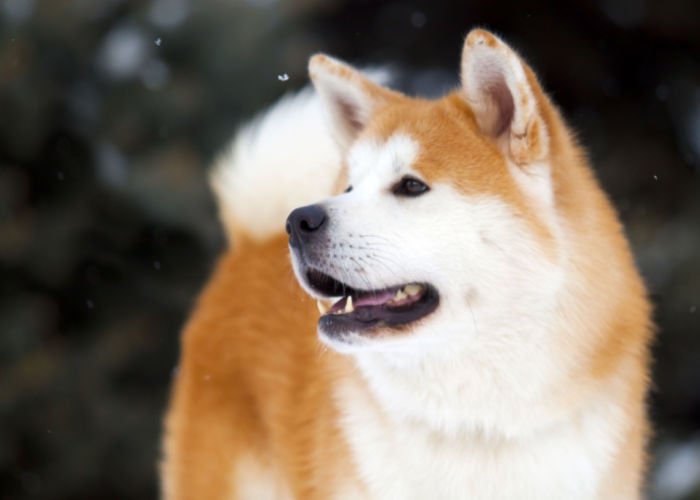Akita Dog Breed Profile – Top Dog Tips
[ad_1]
The Akita dog breed is a muscular dog famous for its courage and dignity. Originally bred for hunting bears, they are a strong and determined canine companion you can trust.
Nowadays, the Akita is still capable of tracking. Its catlike movements make them skillful enough to move quickly and easily.
Like a cat, an Akita dog stalks its prey quietly and will not give a warning before leaping into action. Its feline trait also includes licking its body as a grooming habit.
Akita dogs are large but are calm and quiet which means they seldom bark if the situation warrants it. They are affectionate, playful, and reserved when it comes to their owners.
Recognized as a breed by the American Kennel Club in 1972, this big furry Akita breed has roots in Japan. You might be familiar with Hachiko, a Japanese Akita dog remembered for his loyalty.
His owner was a professor who commuted to work every day on the train. The devoted dog met him daily at the train station.
Hachiko faithfully waited for the return of his deceased owner for years. Now, he is well known for his remarkable devotion to his owner whom he waited for over nine years until his death.
Akita Dog Breed
Height and Weight
A full-grown American Akita is a burly, heavy-boned spitz-type dog of imposing stature. It is the largest of all the Japanese breeds.
It is a large, dignified dog breed standing 24 to 26 inches for females and 26 to 28 inches for males. Females weigh from 70 to 100 pounds, while males scale from 100 to 130 pounds.
Coat
The coat is thick and dense that comes in different colors. The Akita has color combinations and well-defined patterns across its muscular body.
Feature
An Akita puppy grows into a sizeable adult as a sturdy breed.
It has a broad and massive head with triangular pointy ears and small eyes. An Akita dog’s peculiar tail raises over his back in a fluffy curl.
Trait
In the household, it enjoys carrying toys and other items around in its mouth. This mounting trait is an Akita breed’s way of communicating with those it loves.
It wants to take part in the family’s daily affairs because it thrives on companionship. When bored and lonely, the Akita dog breed can become aggressive and destructive.
Akita Family Life
This dog has a strong personality making it an excellent protector of the house back in the day in Japan.
Akitas enjoy the company of their owners making them fine family dogs. They prefer to be with their family members because they bond closely with their humans.
The Akita dogs are happiest as the only fur baby because they get jealous when you give attention to other pets. For that very reason, this loving type of dog is best suited to a one-dog household.
Not only do they tend to be aggressive toward other dogs, but Akita breeds are wary towards strangers. They are fearless but loyal to their families, hence not fond of unfamiliar people.
Akita dog breeds are intensely protective by nature and highly territorial. Exposure of Akita puppies to people and other dogs can help soften the edge of their alertness but will not be socially active.
Japanese Akita VS American Akita
The Japanese dog breed is known as the Akita Inu.
It looks the same as the American Akita dog but smaller in height and mass. American Akitas have bear-like heads while Japanese Akitas are foxlike.
Their standards differ as well. American Akita dogs appear in all colors, while the Akita Inus have a limited range of colors.
The American Akita has a variety of brown and tan shades. The Japanese Akita only comes in red, brindle, and black colorations.
Akita Dog History
The Akita originated in the Akita Prefecture of northern Japan where it got its name. Known as a symbol of protection, it was a watchdog and a hard-working hunting dog.
The Akita breed has a spiritual significance. It symbolizes good luck to the Japanese people.
When a child is born in Japan, the family will receive a small statue of an Akita dog for health, happiness, and long life.
It made its way to America and was introduced by Helen Keller. She admired and grew fond of the Akita dog breed after knowing the story of Hachiko.
While traveling in Japan, she got interested in having one of her own. When Keller returned to the USA, she was accompanied by this type of dog.
She acquired an Akita puppy named Kamikaze-Go but died of distemper at a young age. She received another puppy which is Kamikaze’s brother, Kenzan-go.
American servicemen also brought back more Akitas from overseas after World War II.
Akitas were declared and are now considered Japan’s national treasures.
Akita Breed Health
Like many dogs, some hereditary health issues can occur in the Akita dogs. Owners need to consult with their veterinarians about precautions when signs occur.
Hip Dysplasia:
It is the malformation of the hip joints that can lead to pain and lameness. Arthritis develops as the dog ages.
However, there are also factors that contribute to this condition aside from old age. It could be hereditary, accidents, or poor diet.
Gastric Dilatation-Volvulus:
Gas production happens due to eating and drinking rapidly. Bloating becomes life-threatening once the stomach twists and cuts off the blood supply.
Hypothyroidism:
This is a disorder of the thyroid gland. Hypothyroidism is often characterized by reduced energy, unexpected weight gain, and behavioral changes.
Fortunately, this condition is something that diet and medication can correct. Just make sure to consult with your vet as soon as you see the symptoms.
Sebaceous Adenitis (SA):
It is a genetic skin condition in Akita breeds. The infection leads to the inflammation and destruction of the glands in the skin.
Affected Akita dog breeds have dry, scaly skin and loss of hair on the head, neck, and back.
Progressive Retinal Atrophy (PRA):
This condition is the gradual worsening of the retina. It causes limited or lost vision in the affected dog.
How to Care for Akitas
As dog owners or soon-to-be fur parents, you need to understand the obligation of dog ownership. Focus on its wellness through routine care, diet, and exercise.
Exercise
The Akita needs daily exercise to keep them from becoming bored. An idle Akita dog could lead to behavior problems such as becoming destructive.
Roaming in the yard or jogging will suffice. Visiting a dog park might not be a good idea, given the fact that the Akita breed is aggressive towards other dogs.
A long or short walk not only relaxes it but also calms its mind.
Training
Before owning an Akita dog breed, it is crucial to research how to train this particular dog. If not raised properly, it becomes aggressive.
Positive reinforcement and proper socialization at an early age are the keys to overcoming this tendency. Thus, training is important, and so is socializing the Akita puppy or retraining an adult dog.
Patience is necessary for teaching the proper canine manners. This powerful breed is stubborn and hence not that easy to train.
The training needs to be consistent and firm. If mishandled, it can become hostile.
Grooming
Although it is seasonal when it happens, the Akitas shed a lot. Weekly brushing helps reduce the amount of hair in your home and keeps the coat healthy.
Akita dogs have the potential to drool but they keep themselves clean and odorless. With their feline behavior, they lick their body like a cat.
Despite their self-grooming habits, they still need bathing. It also pays to use the right grooming tools for your pooch.
Trim the nails and check the ears regularly. Remember to brush their teeth to ensure dental health.
Diet and Nutrition
Akita breeds do well on a high-quality, low-calorie diet. The better the dog food, the further nourishment it gives to your dog.
Treats are important during the training, but giving too many can cause obesity. Watch your pet for weight gain and discuss any special needs with your veterinarian.
Akita dog breeds are prone to getting overweight, thus the recommended daily amount is 3 to 5 cups of food a day. The food may be commercially manufactured or home-prepared.
Their calorie consumption will have to depend on their age, size, and activity level.
Ideal Owners of Akita Dogs
People often get the Akita without a clear understanding of what goes into keeping one.
This dominating dog is not for a first-time owner. Its strong personality can be overwhelming for the timid.
Large and in charge, it needs an owner who is calm but consistent and firm in providing discipline.
Akitas don’t respond well to harsh training methods. They need positive reinforcements and a confident handler.
Owning an Akita dog also means having a fenced yard for the safety of strangers whom your pet may think to be a threat.
The Akita dogs are loyal guardians and will protect you against anything. They will follow you from room to room in your home to go with you and keep you safe from harm.
The Akita breed is not suitable for everyone because its large size can make it difficult to control.
This dog has strength and endurance. You need to understand the responsibility that dog ownership requires.
Akita breeds are best suited to an experienced owner and a home with older children. Breeders and rescue groups usually do not release this breed into a home with young kids.
The Akita dog breed is loyal to any family members but may endanger your child’s life when one mistreats the dog.
To start your search for Akita puppies, you can look at rescue groups such as the Akita Club of America.
Before deciding if it is the right dog for you, invest time in checking breed organizations. Learn more information about the Akita dog breeds from reputable breeders.
Many of them need adoption. Find a rescue organization or a shelter that demands applicants to check on the dogs if they are a good fit for the possible forever home.
FAQs about Akita Breed
Does the Akita dog breed bite its owner?
Yes, they attack even their owners. Akitas are the third most likely dog breed to bite someone unprovoked.
How much does an Akita dog breed cost?
Akitas are costly so the amount is quite high.
The average Akita dog price is between $700 to $1,600 for an Akita puppy. Purebred offspring coming from parents who’ve won dog competitions can cost as much as $4,000.
Is an Akita dog breed hard to train?
Training can be a challenge because the breed is strong-willed, and bores easily. Careful supervision is a must and takes a lot of patience, understanding, and experience to train this aggressive breed.
This type of dog is fit for owners who can and will invest time and effort in research and proper training.
Akita Dog Breeds: Summary
The Akita is an independent dog that originated in the mountains of northern Japan. In the past, this dominant breed tracked and hunted wild boars and bears.
Today, the Akita breed is a companion dog to some. Others have them compete in tournaments or as therapy dogs.
Even though it is generally aloof with strangers, the Akita dog is an affectionate and loyal family member. It is fearless and a trusted guardian of its owner.
The Akita dog breed’s physical traits include a bear-like head with erect, triangular ears and small eyes.
Akitas have thick double coats and tails that are over the top of their back in a curl.
Japanese Akitas have a restriction in color. American Akitas are larger and heavier, come in several different colors, and frequently have black masks on their faces.
Akita dogs are low maintenance because they tend to groom themselves like a cat. They are heavy shredders hence owners should prepare for some cleanup.
With early socialization and consistent training, they may be able to interact with other animals. They may willingly accept new people even though they are territorial and reserved with strangers by nature.
Obedience training is a need. Being intelligent dogs, the Akita breeds learn quickly but can be stubborn.
Akita dog breeds will be excellent protectors but not as family dogs with small children and other pets due to their aggression issues. As with any large breed, children and dogs need supervision.
The Akita is commonly hard to control and so is not suitable for everyone. If you are up for the challenge and consider adopting an Akita, you will have a faithful companion and a lifelong friend that will shower you with adoration and love.
RECOMMENDED: 20 Most Aggressive Dog Breeds
Related
[ad_2]
Source link











robaxin 750 mg